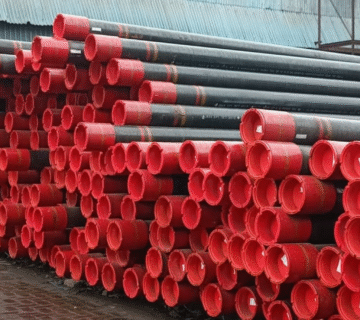Choosing the right drill pipe size is one of the most critical decisions in any drilling operation. A pipe that doesn’t match the wellbore design risks poor circulation, tool sticking, or structural failure under pressure. On the other hand, a properly sized pipe stabilizes the well and ensures safe, reliable drilling progress.
Beyond structural compatibility, pipe dimensions govern hydraulic efficiency. The inner diameter controls drilling fluid circulation, which directly affects cuttings transport, bit cooling, and penetration rates.
A mismatch in size can slow operations, compromise hole cleaning, and increase non-productive time.
In this blog, we’ll break down drill pipe sizes, classifications, and how to make the right selection.
Types of Drill Pipes
1. Standard Drill Pipe
Standard drill pipe is the most widely used tubular in drilling operations. It forms the central section of the drill string, linking the surface rig equipment to the bottom-hole assembly. Typically ranging from 27 to 32 feet in length, standard drill pipes are designed to withstand the combined effects of tensile load, torsional stress, and internal fluid pressure.
Their balanced construction makes them ideal for vertical and moderately deviated wells, ensuring effective drilling fluid circulation while maintaining mechanical strength.
2. Heavy Weight Drill Pipe (HWDP)
Heavy weight drill pipe is designed with thicker walls and increased weight compared to standard drill pipe. Positioned between the drill collars and the standard drill pipe, it acts as a transition section that reduces stress concentrations and fatigue failures.
HWDP provides added stability, which is particularly beneficial in directional, horizontal, and extended-reach wells. Its strength allows it to handle bending stresses without compromising the flexibility needed for steering.
3. Drill Collars
Drill collars are heavy, thick-walled tubulars used at the bottom of the drill string. Their primary function is to apply weight on the drill bit, keeping it in firm contact with the formation. By adding rigidity, drill collars minimize vibrations, reduce unintentional well deviation, and improve the bit’s efficiency in penetrating rock formations. They also help prevent buckling of the drill string in deep and challenging wells.
4. Specialty Drill Pipe
Specialty drill pipes are engineered for extreme environments, such as deepwater or HPHT (high-pressure, high-temperature) wells. These pipes are often manufactured with corrosion-resistant alloys, sour-service grades, or advanced tool joint designs that provide superior torque capacity.
Specialty drill pipes ensure safe performance in environments where standard tubulars might fail, such as wells with high hydrogen sulfide content or reservoirs requiring exceptional tensile strength.
Standard Drill Pipe Sizes and Weights
Standard drill pipe sizes and weights form the foundation of drilling operations, dictating strength, circulation capacity, and handling requirements. Each size is engineered to perform optimally under specific well depths and conditions. Understanding these classifications helps operators select the right pipe for balancing durability, efficiency, and cost-effectiveness in drilling programs.
| Drill Pipe Size | Weight Range (lb/ft) | Ideal Applications | Advantages | Limitations |
| 2⅜” | 6.65–10.40 | Slim-hole drilling, shallow wells, workover operations | Lightweight, easy to handle, suitable for limited rig setups | Low fluid circulation and load capacity |
| 2⅞” | 10.40–14.70 | Medium-depth wells, shallow horizontal wells, water well drilling | Balance of strength and fluid capacity, economical | Less robust for deep/high-pressure wells |
| 3½” | 13.30–20.70 | Onshore oil & gas drilling, geothermal wells, directional drilling | Strong tensile strength, torque, and fluid handling | May not offer enough capacity for deep offshore wells |
| 4″ | 14.00–21.00 | Deeper wells needing more stability | Transitional size between 3½” and 4½”, good compromise | Less strength than larger pipes, less efficient than smaller ones |
| 4½” | 16.60–21.90 | Medium to deep oil & gas wells, extended-reach & directional drilling | Strong structural strength, reduces fatigue, good hydraulic efficiency | Heavier handling requirements |
| 5″ | 19.50–27.60 | Deep wells, offshore projects, HPHT wells | Standard size, excellent tensile strength and torque, versatile | Heavier and more expensive to handle |
| 5½” | 21.90–30.70 | Deepwater offshore drilling, long horizontals, extended-reach wells | High load capacity, supports complex drilling assemblies | Increased handling/transport costs |
| 6⅝” | 25.20–39.00 | Ultra-deep wells, offshore HPHT drilling, heavy-duty operations | Maximum strength, hydraulic efficiency, designed for extreme environments | Expensive, very heavy, requires specialized rigs |
1. 2⅜” Drill Pipe (6.65–10.40 lb/ft)
This is the smallest commonly used drill pipe size. It is lightweight and best suited for slim-hole drilling, shallow wells, and workover operations. Its reduced OD makes it easy to handle but limits fluid circulation and load capacity.
2. 2⅞” Drill Pipe (10.40–14.70 lb/ft)
Slightly larger than the 2⅜”, this size is used for medium-depth wells, shallow horizontal wells, and water well drilling. It offers a balance of strength and fluid capacity while remaining economical.
3. 3½” Drill Pipe (13.30–20.70 lb/ft)
One of the most widely used sizes in the industry, 3½” drill pipe is common in onshore oil and gas drilling, geothermal wells, and directional drilling. It provides a strong mix of tensile strength, torque capacity, and fluid handling.
4. 4″ Drill Pipe (14.00–21.00 lb/ft)
This size is less common but is often applied in deeper wells where more strength and stability are needed. It serves as a transitional option for operators who require more capacity than 3½” but less weight than 4½”.
5. 4½” Drill Pipe (16.60–21.90 lb/ft)
Popular in medium to deep oil and gas wells, 4½” drill pipe provides enhanced hydraulic efficiency and structural strength. It is often chosen for extended-reach drilling and directional programs because it reduces fatigue while maintaining drilling fluid circulation.
6. 5″ Drill Pipe (19.50–27.60 lb/ft)
This is a standard for deep wells and offshore projects. With higher wall thickness options (19.5, 25.6, or 27.6 lb/ft), it provides excellent tensile strength and torque capacity, making it ideal for HPHT wells and demanding formations.
7. 5½” Drill Pipe (21.90–30.70 lb/ft)
A heavier-duty option, 5½” pipe is widely used in deepwater offshore drilling, long horizontal wells, and extended-reach programs. Its higher load capacity supports complex drilling assemblies and large volumes of drilling fluid circulation.
8. 6⅝” Drill Pipe (25.20–39.00 lb/ft)
This is the largest standard drill pipe size. It is applied in ultra-deep wells, offshore HPHT drilling, and heavy-duty operations requiring maximum strength and hydraulic efficiency. However, its size and weight make it more expensive to transport and handle.
Drill Pipe Lengths and Range Classifications
Choosing the right drill pipe length impacts both operational efficiency and project economics:
- Hydraulics: Longer pipe reduces turbulence from tool joints, improving drilling fluid circulation.
- Rig Time: Fewer connections mean faster trips and less wear on threads.
- Safety: Properly matched lengths prevent overloading hoisting systems or causing handling risks.
- Cost: While R3 requires higher investment, it lowers overall operational costs in deep, complex wells.
Let’s understand the various drill pipe lengths and range classifications:
| Range | Length | Use Cases | Advantages | Limitations |
| Range 1 (R1) | 18 to 22 feet | Shallow drilling, workover operations, older rigs with limited derrick height, and space-constrained sites. | Useful where longer pipes cannot be handled safely. | More connections required, higher thread wear and tool joint fatigue, less cost-efficient for long-duration drilling. |
| Range 2 (R2) | 27 to 32 feet | Standard for most operations, onshore and offshore wells, and shallow to moderately deep exploration. | Balance of efficiency and manageability, fewer tool joints than R1, better hydraulic flow, easier procurement and logistics. | Less specialized than R3, moderate length may not maximize efficiency in deepwater or extended-reach wells. |
| Range 3 (R3) | 38 to 45 feet | Deepwater drilling, extended-reach wells, and ultra-deep exploration projects. | Longest pipes reduce tool joints, minimize connection time, and improve hydraulic efficiency. | Requires rigs with greater clearance, stronger hoisting systems, and specialized handling equipment; higher upfront costs. |
1. Range 1 (R1): 18 to 22 feet
Range 1 drill pipe is the shortest category. It is typically used in shallow drilling, workover operations, or older rigs with limited derrick height. Because the joints are shorter, rigs must use more connections to build the drill string, which increases time spent making and breaking connections.
This also accelerates thread wear and tool joint fatigue, making R1 less cost-efficient for long-duration drilling. However, it remains valuable in space-constrained operations where longer pipes cannot be safely handled.
2. Range 2 (R2): 27 to 32 feet
Range 2 is the industry standard and accounts for the majority of drill pipe in service worldwide. It strikes the ideal balance between manageability and efficiency. R2 reduces the number of tool joints compared to R1, lowering risks of connection failure and improving hydraulic flow.
It is widely used in onshore and offshore wells, from shallow formations to moderately deep exploration. Because most drilling rigs and storage systems are designed with R2 in mind, procurement and logistics for this range are straightforward, making it the default choice for most projects.
3. Range 3 (R3): 38 to 45 feet
Range 3 drill pipe is the longest and most specialized classification, primarily used in deepwater drilling, extended-reach wells, and ultra-deep exploration projects. The extended length significantly reduces the number of tool joints in the drill string, which minimizes connection time, fluid turbulence, and potential leak points.
This improves hydraulic efficiency and reduces non-productive time. However, the longer length comes with trade-offs: it requires derricks with greater clearance, stronger hoisting systems, and specialized handling equipment. While R3 has higher upfront costs, it provides time savings and performance advantages in demanding offshore environments.
Drill Pipe Grades and Material Strength
Choosing the right drill pipe grade is critical because it determines how the pipe responds to tension, torque, bending, and corrosive environments. Lower grades offer affordability and flexibility but have strength limitations, while higher grades provide durability and resistance for demanding wells.
Premium sour-service grades protect against hydrogen sulfide and extreme downhole conditions.
| Grade | Yield Strength (psi) | Key Characteristics | Applications |
| E-75 | 75,000 | Lowest-strength API grade, highly ductile, and easy to handle. | Shallow wells, light drilling, and workovers. |
| X-95 | 95,000 | Balanced strength and flexibility. | Medium-depth wells and moderate loads. |
| G-105 | 105,000 | Higher tensile/torsional strength, and good fatigue resistance. | Deeper wells and directional/horizontal drilling. |
| S-135 | 135,000 | Maximum strength, excellent torsional and fatigue resistance. | HPHT wells, ultra-deep wells, and offshore drilling. |
| Premium/Sour Service | Varies (≥135,000+) | Enhanced alloys, resistant to H₂S, corrosion, and cracking. | Sour gas fields, HPHT, and deep offshore environments. |
Factors to Consider When Selecting Drill Pipe
Selecting the right drill pipe goes beyond diameter and weight. Every well environment presents unique mechanical and operational challenges, making proper evaluation essential. Below are the most critical factors:
1. Well Depth and Pressure Conditions
Deeper wells impose higher axial, torsional, and bending loads on the drill string. High-strength grades like G-105 or S-135 are better suited for ultra-deep or HPHT wells, while E-75 suffices for shallow applications. Matching depth and grade prevents premature fatigue or failure.
2. Hole Diameter and Rig Compatibility
The wellbore size determines pipe outer diameter, while the rig’s handling system limits what can be used. A mismatch can strain elevators, rotary tables, and top drives. Standard drill pipe sizes of 3 ½”, 4 ½”, and 5″ align with most rig designs, balancing performance and efficiency.
3. Formation Characteristics
Hard, abrasive formations require stronger drill pipe with tool joint protection to handle torque and wear. Conversely, softer formations may allow the use of lighter grades and thinner walls, reducing overall string weight and costs.
4. Corrosive and Sour Service Environments
Presence of CO₂, H₂S, or saline water accelerates corrosion and sulfide stress cracking. Specialized sour service or premium grades resist these threats, ensuring longer service life and compliance with safety standards.
5. Torque and Drag Requirements
In deviated, horizontal, or extended-reach wells, torque and drag escalate significantly. Pipes with optimized connections and high torsional strength minimize risks of sticking, excessive wear, and costly downtime.
6. Weight and Handling Efficiency
Heavier drill pipe increases load on rigs and logistics, while lighter pipe may lack needed strength. Balancing weight with tensile capacity ensures safe handling, efficient transport, and reduced operational strain.
7. Cost vs. Performance
Premium drill pipe commands higher costs but delivers reliability in demanding environments. For routine drilling, mid-grade options may provide an economical balance. Lifecycle cost—including inspection, maintenance, and replacement—must be weighed against upfront price.
Optimize Your Drilling Projects with the Right Drill Pipe Sizes
Selecting the correct drill pipe size, weight, and grade is fundamental to ensuring well compatibility, hydraulic efficiency, and rig safety. AZM Oilfield stands as a trusted partner in supplying API-certified drill pipes and accessories tailored to diverse well conditions.
With more than $27 million in executed orders and a proven track record across the Middle East and Africa, we ensure reliability at every stage. Our team of senior drilling technology experts guide clients in selecting drill pipe sizes and grades suited to their exact drilling programs, while our global logistics network handles breakbulk and container shipments with precision.
Contact us now for API-certified drill pipes and OCTG items.
Frequently Asked Questions
Drill pipe sizes typically range from 2⅜ inches to 6⅝ inches in outside diameter. Each size serves specific well depths and drilling conditions, balancing fluid circulation, strength, and load capacity. Smaller pipes suit shallow or slim-hole drilling, while larger diameters are essential for deepwater, HPHT, and extended-reach wells requiring maximum tensile strength and hydraulic efficiency.
Oil drill pipe wall thickness varies depending on its size and grade, typically ranging between 0.280 inches and 0.500 inches. Thicker walls are designed to handle high internal pressure, torque, and bending stress in demanding drilling environments. The exact thickness depends on the pipe’s outside diameter, weight class, and intended drilling application, such as shallow wells or deep offshore projects.
The five common drill pipe grades are Grade E, X-95, G-105, S-135, and V-150. Each grade specifies tensile strength, yield strength, and toughness required for drilling environments. Grade E is widely used for shallow wells, while S-135 and V-150 are designed for high-strength applications like deepwater and HPHT wells. Higher grades withstand extreme torsional, axial, and bending stresses.
Oil drilling uses drill pipes, drill collars, and heavy-weight drill pipes (HWDP). Standard drill pipes form the main drill string, connecting the rig to the drill bit. Drill collars add weight to maintain bit contact with the formation, while HWDP provides a transition section that reduces stress. Specialty drill pipes are used in deepwater or HPHT wells.
The difference lies in classification by wall thickness and strength. #1 drill pipe is new or premium, with minimal wear, meeting full API standards. #2 drill pipe has moderate wear and reduced wall thickness, making it more affordable but less durable. Operators often choose #1 for demanding projects and #2 for less critical or cost-sensitive operations.
To identify drill pipe size, measure its outside diameter (OD) using calipers or a pipe gauge. The OD determines the nominal size classification, while the weight per foot provides additional specification. Pipe markings, usually stenciled or stamped, also display size, grade, and weight class. Accurate sizing ensures compatibility with connections, drilling assemblies, and rig handling equipment.



